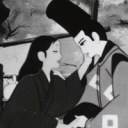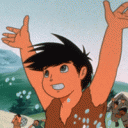Tribute to Toei Animation - The Golden Age of Japanese Animation
(edited by Luca Della Casa)
Toei Animation was the first Japanese animation studio, and is still one of the most important in the world in terms of success of its productions and their number: over 160 TV series and 180 feature films so far. Born in Tokyo at the end of
the forties as a section of production company Toei, in 1958, it produced the first color animated feature film which has ever been realized in Japan, The White Snake Enchantress (Hakujaden), directed by founders Taiji Yabushita and Kazuhiko Okabe. Future Film Festival will pay a tribute to this studio, at 60 years from its birth and 50 from its first film, by proposing a list of classics belonging to the history of animation:
Hakujaden (The White Snake Enchantress) by Yabushita Taiji, 1958
The first color feature-length animation film in Japanese history, Hakujaden (The White Snake Enchantress) is a rather large production, involving 42 animators and over 10,000 assistants. Toei Animation chose a traditional Chinese legend as its first major production, Bai Su Zhen: the search
of a soulmate throughout one’s life, and the love story between the young Xu Xian and the beautiful Bai Niang, the human reincarnation of a snake spirit.
Anju to Zushiomaru (The Orphan Brother) by Yabushita Taiji and Serikawa Yugo, 1961
Anjo to Zushiomaru, released in Italy as Robin e i due moschettieri e mezzo (“Robin and the two and a half musketeers”), is an adaptation of a Mori Ogai novel, Sanshô Dayu (Sansho the Bailiff), first adapted by the famous director Mizoguchi Kenji in 1954. The story, set in a medioeval Japan, tells the adventures of an unlucky family whose children, Aniu and Zushio, are separated against their will. The two will have to cross many difficulties before meeting again and re-joining their mother, who they thought to be dead.
Taiyo no Oji: Hols no Daiboken by Takahata Isao, 1968
A real turning point in Japanese animation film, Taiyo no Oji: Hols no Daiboken (The Little Norse Prince), is the first directorial venture of Takahata Isao, Miyazaki Hayao’s teacher and collaborator (they later established Studio Ghibli together). For the first time, the story was not told from a child’s perspective, but aimed at an in-depth analysis of the characters’ feelings. Camera movements and wide-angle shots bring action to the foreground.
At the time of his dad’s death, young Hols sets out on an initiation journey through lands threatened by snow. During his journey, he comes across a stone giant and an ancient sword, the legendary Sun Sword, which can melt the ice and help him fight against horrible wolves led by the mean Grunwald, who has subdued the Northern lands.
Hyokkori Hyotan jima (The Madcap Island) by Yabushita Taiji, 1967
Hyokkori Hyotan jima is a nonsensical version of The Treasure Island, known in Italy as La strana isola (The Odd Island).



